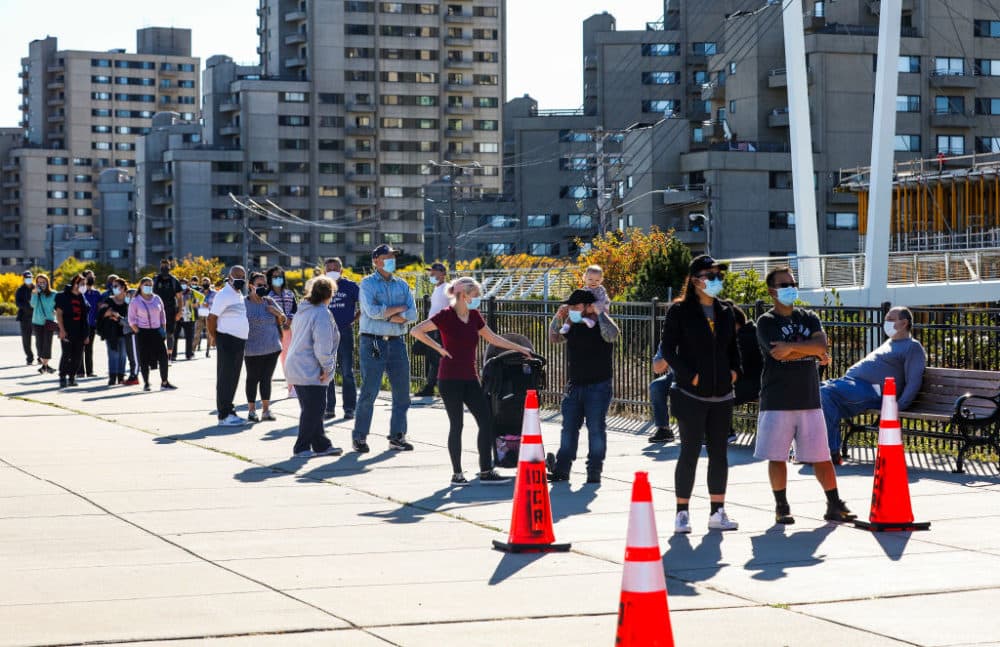Advertisement
Coronavirus Coverage
The Next Wave: How This Mass. Coronavirus Surge Compares To The Spring
Resume
This week, it became official: Massachusetts is in the throes of a second coronavirus surge.
Gov. Charlie Baker says so. Asked if he considers the recent rise in cases a surge, he answered: "Yeah. We are in the midst of what was expected and anticipated by a lot of folks in the public health and epidemiological community last spring — which is that there would be an echo associated with this, and it would land in the fall."
But this surge is not just an "echo" of the spring; in some ways it's very different.
First, the similarities: Whether you call it a surge or a wave or a spike, the state is obviously in a period of sharp growth in the number of cases.
"Since Labor Day, cases have increased by over 300%, and in the same period of time, hospitalizations by nearly 200%," Baker said.
The number of COVID-19 patients in the state's ICUs has roughly tripled as well. The virus tracking in wastewater is shooting up, reaching levels reminiscent of spring. And if you subtract out the college students, nearly 5% of coronavirus tests are positive — that’s compared to under 1% in late summer.
The numbers of cases detected are starting to look almost comparable to the peak of the spring surge — a couple of thousand confirmed cases a day.
Now for the differences: Some metrics are much better these days. For example, the number of people hospitalized with COVID was heading toward 700 this week; in May, it hit nearly 4,000.
Deaths tend to lag behind the case numbers and are likely to rise, but so far, the number of people dying is dramatically lower than in the spring.
Back then, there were many days when well over 100 people died of COVID; in recent days, the numbers of people who die have tended to hover in the teens or twenties, though on Wednesday, the death toll rose to 37.
The central difference, it seems clear, is the age of people infected. Compared to the spring, when the virus ripped through the state's nursing homes, older adults are just not catching it as much.
Dr. Rochelle Walensky, the chief of the division of infectious diseases at Mass. General Hospital, points out that if you look at the age distribution of people who test positive lately, it goes right across the board.
"If you just do the math, in April, when we were in our surge, over 60% of our cases were over 60 years old, and now they’re less than 20%," she says.
The average age of people who die is 80, but the 80-and-above age group is only a small sliver of cases now.
It's not clear whether the lower death toll also stems from improvements in treating COVID. Certainly, medical staffers have learned about keeping COVID patients alive. But large-scale studies have yet to show a definitive effect of better care on mortality.
"As we’ve seen a shift in the demographics of who is testing positive for COVID-19 to younger and younger people in our communities, that is expected to lead to better outcomes," says Dr. Kathryn Hibbert, director of the medical ICU at Mass. General. "And so it's been a little hard to disentangle."
'A Big, Bad, Steady Swell'
So given the current numbers, what shape can the state expect this new coronavirus wave to take? Massachusetts is generally good at wearing masks and other public health measures, so could it end up like an ocean swell that never rises up too high? Or will it crest sharply?
Dr. Walensky expects a long, high winter wave.
"I don’t necessarily feel like we’re going to hit this tidal wave and then have a screeching halt when everybody just stays home — because people are not just staying home anymore," she says. "But I do think it’s going to be a big, bad, steady swell."
She's also raising some fresh concerns about monoclonal antibodies, the type of drug that President Trump credited with helping him beat down the virus. This week, a different monoclonal antibody, called bamlanivimab and made by the drug company Eli Lilly, gained emergency federal approval.
In initial data, it appears to improve the outlook for patients early in the course of the illness. So it could be a step toward desperately needed early treatments to stop COVID from getting bad.
But one major concern Dr. Walensky raises is the logistics of setting up venues where early COVID patients can get infusions of these antibodies. It's a daunting prospect when you imagine numerous potentially infectious people — outpatients — who need a place to spend an hour or two with an IV.
Other concerns: Initial supplies of the drug will be small. Who will get them? And will people from vulnerable communities have access? If many lack primary care physicians and access to hospitals, will they be able to get infused within the recommended three-day window after a positive coronavirus test?
"The logistics of of trying to make sure that there's equitable access are just extraordinary," Walensky says.
This segment aired on November 13, 2020.
